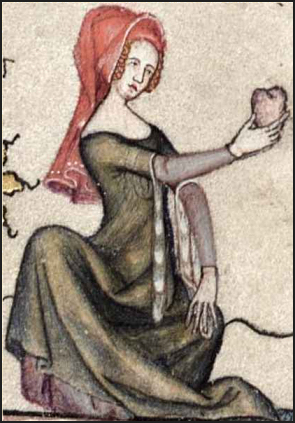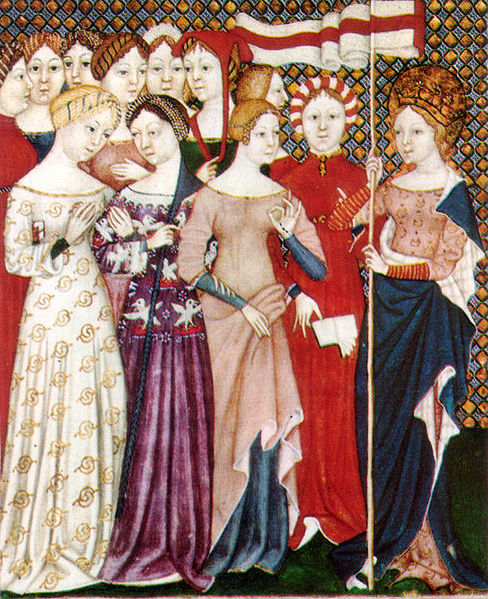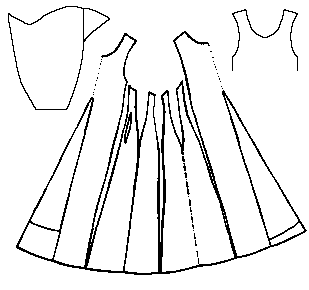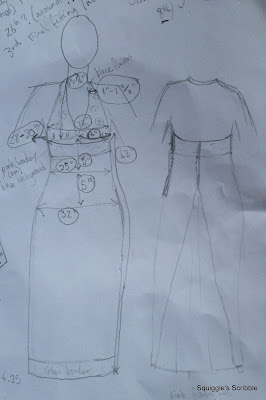Part 1 Summary:
http://nutty-vix.blogspot.co.uk/2011/03/of-pondering-of-early-corsets.html
The last discussion briefly covered studying the effect and body language of figures in Medieval portraits and paintings. The combination of artistic licence, medieval symbolism and a modern understanding of how natural materials shape and form have made the beginnings of a somewhat ambiguous debate over the origins of the corset. We also covered the power of personal experimentation and how the development of tailoring changed the way they chose to manipulate and display the figure, be it for medical, practical or cosmetic reasons. This progressed onto how they might have gone about creating 'bodies' or stiffeners for torsos - buckram, glue and hemp cording and wood were considered.
Part 2
After another long period of mulling over, someone has resurfaced the topic and renewed my interest in early corsetry, so here (finally) is Part 2. Over a year on, and the Squiggle's ideas have yet further developed! I've also come across some more possible primary evidence, both for external and internal shape forming.
One of the wonderful things happening over the last year has been the release of more close-up photographs and studies of certain well-known sources, such as the 'Closer to Van Eyck' study of the Ghent Altarpiece:
http://vaneyck.kikirpa.be/
My first ever 'posh' frock was based on one of the houppelande gowns depicted on here, yet there was a limit to how much I could observe in a tiny jpg image a few years ago!
Inevitably, this amazing close up study has revealed flaws in what I thought I could see and the exact garment construction and layering. For a start the 'V-neck' opening extends far deeper than I first imagined. It goes to show that you should always review your own interpretations, even if you are convinced that you've got it right! Hence this post.
Of Holding Everything Up and In!
You may have noticed that I've acquired a wide leather girdle in the last year too! My partner Matt made it for me and has kindly let me borrow a business photo of it:
So why am I side tracking on the topic of belts? Well, one of the things I've noticed about wearing a wide leather girdle is a sensation not dissimilar to wearing a corset! So not only would have a wide girdle represented a woman's wealth, it would additionally provide considerable physical support. Such a girdle was particularly popular with the Burgundian style gowns, as it looked best worn directly under the bust (good bust support too perhaps?).
Hugo van der Goes (1440-1482), Saints Margaret And Mary Magdalene (background) with Maria Portinari (1476-1478)
Which brings me to the next observations of Maria Portinari and her daughter (?), as pointed out by my friend Caroline. Maria (left) is wearing an extra-ordinarily wide girdle in an wealthy looking, impractical white/cream colour. Look slightly down. What are those ridges in her skirt? A very stiff petticoat? A hooped skirt in its infancy? Tabs from a bodice of some description sticking out?
Now look across to the young girl. What doesn't look quite right? She could be perhaps somewhere between eight and fourteen years old? Old enough to be being prepared as a bride. Although she has the stature of a child, her waist comes in and flares out lightly over the hips in an odd fashion. Enough waist in fact that she can hang a belt on it! Even if there is a petticoat under the skirt, what's bringing in her waist? Also ask yourself this: If children were dressed alike to their parents, why go to all the effort of having a front laced gown on your growing daughter when the girdle is such a simple solution? Is the girdle simply a social status symbol, or does it tell us more about how they viewed displaying young figures of a marriageable age? Very fishy.
Let's start to look again at body shaping possibilities, from the inside outwards.
Bandaging
For those with a limited budget, this is an option! Babies were swaddled, so it stands to reason that children alike may too have been wrapped to ensure that they grew straight. However doing it well could entail having additional help and Lots of time. (For those who have watched Shakespeare In Love, it may bring to mind the method Viola used to 'hide' her feminine features).
Shakespeare In Love (1998), Viola's disguise secret is unravelled!
I had a fiddle with some fabric on my waist, both cut on the bias and straight. Cut on the bias, it had stretch and a better flexibility to natural shape although rather soft, whereas on the straight I was able to pull it more taught, but it was harder to manipulate and firm. The tricky bit was keeping it flat and smooth, so the strips had to be narrow and medium-fine in thickness. One of the liberties was that you could cover as much or as little flesh as you wished, which the bias cut was better suited for.
However the average historical re-enactor does not necessarily possess that kind of time and help, both to practice and put through its paces for shows.
Corded bodice
I've chosen this route with string or hemp cord (as opposed to buckram) first because as I found from the bandaging, the softer the material you use, the more you can play with the tension. Second because the sources show softer figures still, rather than the rigid structures so I'm avoiding a completely unnatural appearance. Third because my body is not accustomed to wearing a corset daily, so it puts less strain on my body.
Think of it if you will as a 'vest', warm and protective. I plan to use diagonal as well as vertical lines of cording, for there is more integral strength, particularly down the front. (See Part 3 for further explanation.)
That said if the buckram (or even cardboard) were cut into vertical/diagonal strips/panels and treated like modern corset boning in pockets, it may have a similar effect.
Gentlemen may not wish to cover the whole of their torso, for usually it is triangular shape and the bottom edge of a corset may dig in with little to hold it up. A belt-like support (rather like a wrestling belt? either separate or integral to an outfit) with lacing might be better suited. And although they don't tend to have so much hip for a corset to sit on, they could try slight tabs below the waist seam (if there are jacket tabs) to help it sit right and exaggerate the finish. Any thoughts?
Stiffening of Outer Garments
Only recently it occurred to me that men's arming jackets for war were quilted over numerous layers of fabric, or sewn in tubes and then filled. Very similar to bodice cording! See below. A current Cotun commission has had me mulling over all the different approaches one could take to construction.
Men's Cotun - one of the few illustration examples
1445-1452, Bernat Martorell, Alter of the Transfiguration, Barcelona Cathedral, thanks to Jessamyn's Closet: http://www.jessamynscloset.com/
The image above from Barcelona shows a Lady in an over gown with taught side lacing, with lots and lots of fixed pleats or a cording effect. This shape is striking and smooth and probably adds to to integral warmth of the garment. I've heard suggestions of stiffening along just seams, but it seems to me that the best results are produced when cording is a core part of the construction of a garment itself.
Part 3 to come!





























